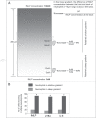Reactive oxygen species as signaling molecules in neutrophil chemotaxis
- PMID: 20714413
- PMCID: PMC2918776
- DOI: 10.4161/cib.3.3.11559
Reactive oxygen species as signaling molecules in neutrophil chemotaxis
Abstract
Neutrophil chemotaxis is a critical component in innate immunity. Recently, using a small-molecule functional screening, we identified NADPHoxidase- dependent Reactive Oxygen Species (ROS) as key regulators of neutrophil chemotactic migration. Neutrophils depleted of ROS form more frequent multiple pseudopodia and lost their directionality as they migrate up a chemoattractant concentration gradient. Here, we further studied the role of ROS in neutrophil chemotaxis and found that multiple pseudopodia formation induced by NADPH inhibitor diphenyleneiodonium chloride (DPI) was more prominent in relatively shallow chemoattractant gradient. It was reported that, in shallow chemoattractant gradients, new pseudopods are usually generated when existing ones bifurcate. Directional sensing is mediated by maintaining the most accurate existing pseudopod, and destroying pseudopods facing the wrong direction by actin depolymerization. We propose that NADPH-mediated ROS production may be critical for disruption of misoriented pseudopods in chemotaxing neutrophils. Thus, inhibition of ROS production will lead to formation of multiple pseudopodia.
Keywords: NADPH oxidase; cell migration; chemokines; chronic granulomatous disease; innate immunity; signal transduction.
Figures



Comment on
- Hattori H, Subramanian KK, Sakai J, Jia Y, Li Y, Porter TF, et al. Small-molecule screen identifies Reactive Oxygen Species as key regulators of neutrophil chemotaxis. Proc Natl Acad Sci USA. 2010 doi: 10.1073/pnas.0914351107. In press.
Similar articles
-
Small-molecule screen identifies reactive oxygen species as key regulators of neutrophil chemotaxis.Proc Natl Acad Sci U S A. 2010 Feb 23;107(8):3546-51. doi: 10.1073/pnas.0914351107. Epub 2010 Feb 8. Proc Natl Acad Sci U S A. 2010. PMID: 20142487 Free PMC article.
-
Structural analysis of human neutrophil migration. Centriole, microtubule, and microfilament orientation and function during chemotaxis.J Cell Biol. 1977 Dec;75(3):666-93. doi: 10.1083/jcb.75.3.666. J Cell Biol. 1977. PMID: 562885 Free PMC article.
-
Chemotaxis in shallow gradients is mediated independently of PtdIns 3-kinase by biased choices between random protrusions.Nat Cell Biol. 2007 Feb;9(2):193-200. doi: 10.1038/ncb1536. Epub 2007 Jan 14. Nat Cell Biol. 2007. PMID: 17220879
-
Is there a pilot in a pseudopod?Eur J Cell Biol. 2006 Sep;85(9-10):915-24. doi: 10.1016/j.ejcb.2006.05.002. Epub 2006 Jun 14. Eur J Cell Biol. 2006. PMID: 16781010 Review.
-
Chemotaxis: insights from the extending pseudopod.J Cell Sci. 2010 Sep 15;123(Pt 18):3031-7. doi: 10.1242/jcs.071118. J Cell Sci. 2010. PMID: 20810783 Review.
Cited by
-
PRBC-derived plasma induces non-muscle myosin type IIA-mediated neutrophil migration and morphologic change.Immunopharmacol Immunotoxicol. 2013 Feb;35(1):71-9. doi: 10.3109/08923973.2012.677046. Epub 2012 Oct 19. Immunopharmacol Immunotoxicol. 2013. PMID: 23083320 Free PMC article.
-
Low dose dextromethorphan attenuates moderate experimental autoimmune encephalomyelitis by inhibiting NOX2 and reducing peripheral immune cells infiltration in the spinal cord.Neurobiol Dis. 2011 Oct;44(1):63-72. doi: 10.1016/j.nbd.2011.06.004. Epub 2011 Jun 24. Neurobiol Dis. 2011. PMID: 21704706 Free PMC article.
-
The Influence of Reactive Oxygen Species in the Immune System and Pathogenesis of Multiple Sclerosis.Autoimmune Dis. 2020 Jun 25;2020:5793817. doi: 10.1155/2020/5793817. eCollection 2020. Autoimmune Dis. 2020. PMID: 32789026 Free PMC article. Review.
-
TREM-1 regulates neutrophil chemotaxis by promoting NOX-dependent superoxide production.J Leukoc Biol. 2019 Jun;105(6):1195-1207. doi: 10.1002/JLB.3VMA0918-375R. Epub 2019 Jan 22. J Leukoc Biol. 2019. PMID: 30667543 Free PMC article.
-
Beneficial effects of dried pomegranate juice concentrated powder on ultraviolet B-induced skin photoaging in hairless mice.Exp Ther Med. 2017 Aug;14(2):1023-1036. doi: 10.3892/etm.2017.4626. Epub 2017 Jun 16. Exp Ther Med. 2017. PMID: 28810554 Free PMC article.
References
-
- Iijima M, Devreotes P. Tumor suppressor PTEN mediates sensing of chemoattractant gradients. Cell. 2002;109:599–610. - PubMed
-
- Funamoto S, Meili R, Lee S, Parry L, Firtel RA. Spatial and temporal regulation of 3-phosphoinositides by PI3-kinase and PTEN mediates chemotaxis. Cell. 2002;109:611–623. - PubMed
-
- Li Z, Dong X, Wang Z, Liu W, Deng N, Ding Y, et al. Regulation of PTEN by Rho small GTPases. Nat Cell Biol. 2005;7:399–404. - PubMed
-
- Li Z, Hannigan M, Mo Z, Liu B, Lu W, Wu Y, et al. Directional sensing requires Gbetagamma-mediated PAK1 and PIXalpha-dependent activation of Cdc42. Cell. 2003;114:215–227. - PubMed
-
- Chodniewicz D, Zhelev DV. Chemoattractant receptor- stimulated F-actin polymerization in the human neutrophil is signaled by 2 distinct pathways. Blood. 2003;101:1181–1184. - PubMed
LinkOut - more resources
Full Text Sources
Other Literature Sources
